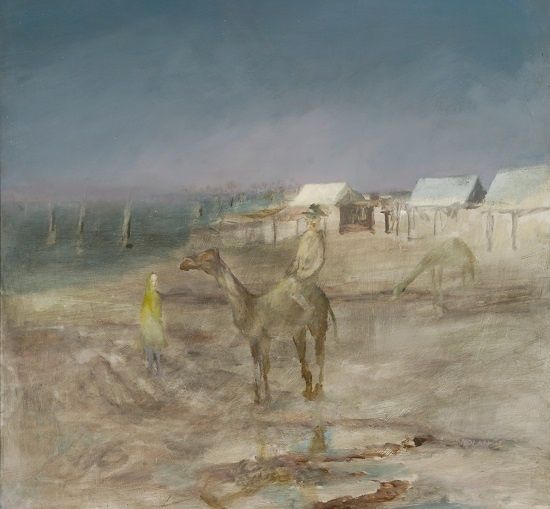

Explorer and Township, 1962
Sidney Nolan, Explorer and township, 1962, oil on composition board, 121.5 x 121.5 cm, The University of Western Australia Art Collection, The Joe and Rose Skinner Bequest, 1981. © Sidney Nolan Trust
Dr Helen Idle is a research associate with the Menzies Centre for Australian Studies at King’s College London. Helen acknowledges the past and present elders of Whadjuk Noongar country and thanks them for their continuing custodianship of their land on which she was born.
“This small white face here, almost hovering at the edge of town, draws me back to her time and again. Her bright green shawl brushes down the side of one cheek, perhaps in preparation for a dust storm predicted by the haze in the distance. She stands silently. The whiteness of her face holds the attention, and the tension, of the painting Explorer and Township (1962) in its muted greens, blues, and browns. What is she thinking? Tall dark marks (figures?) emerge out of the mirage-like horizon toward her, the Explorer faces toward her, she is placed as the focus point in the painting.
Artworks may offer us fresh ways of thinking about being in the world, and viewing Nolan’s paintings anew in 2017 affords new interpretations made in a particular place and time in history. My encounter with this painting was in the storeroom for the art collection of the University of Western Australia, located on Noongar land, Whadjuk Noongar boodja, in Perth, Western Australia, beside the Derbal Yiragan (Swan River). I saw it first in May then again in October.
In the intervening months this petite white face came back to mind to join media images of refugee women from Syria, women in India fighting for their rights, the women of Rohingya fleeing violence. Women displaced, out of place, focussed on surviving each day. She is presented similarly out of place, neither of the township nor of the country. In all likelihood she too is negotiating with agents of power that affect her day to day life.
Looking more closely we can see that she glances out of the painting to her right, directing us and the man on the camel away, out of her realm. The camel seems to acknowledge her presence and authority, and is angled to leave. The Explorer, high above her on the camel, appears skeletal with hollowed eyes and a dark slash for the mouth. On closer inspection the slash is the clasp of a headscarf, his eyes and nose depicted clearly above the wrap and below the hat. As noted by others ambiguity is not unfamiliar in Nolan’s paintings, and so my reading of this particular one continues. The rider may be predicting his own demise by looking dead and alive at the same time. His eyes also look out to the side of the picture, following hers. There is something, somewhere beyond the township and the painting. She may be guarding the country behind her with the support of the sentinels that lead off in two directions towards the horizon, through the watery mirage, marking a boundary between township and country.
Placed here in the centre of the story she is a woman quietly directing events with small gestures. Her story as an ‘explorer’ in this place is harder to imagine than the much-told story of Burke and Wills and others, as seen in Nolan’s Burke and Wills Expedition ‘Gray sick’ (1949), Burke (1962), and Antarctic Explorer (1964). Perhaps she has been sent from Ireland or Britain as a child or on the bride ships, never-the-less, when we imagine the narrative in this painting from her point of view it opens the way to listen to other unheard stories – ones that she glances toward (knowingly). By placing this female figure in plain sight Nolan invites us to consider her, and what she can glimpse.
Assuming she is depicted in country not her own (if she is an explorer) this asks whose country is it that has been appropriated and claimed here by sketchy buildings and a water tank. Kate McMillan notes (No.46) that Nolan was aware that histories of colonial violence and conditions for Indigenous people are occluded by national narratives – those narratives, I am suggesting, are embodied in the figure of the Explorer. The white-faced woman alerts us then to narratives that may be just out of sight to the (whitefella) viewer.
Through the presence of the white-faced figure Nolan offers the us a chance to think again about which stories of nations get told, by whom and how. He encourages us to consider multiple ways of being in, and thinking about, the stories of people inhabiting this continent we now call Australia. This is not my ‘favourite’ painting but I accepted its provocation there hanging in the stores in Whadjuk Noongar boodja.”